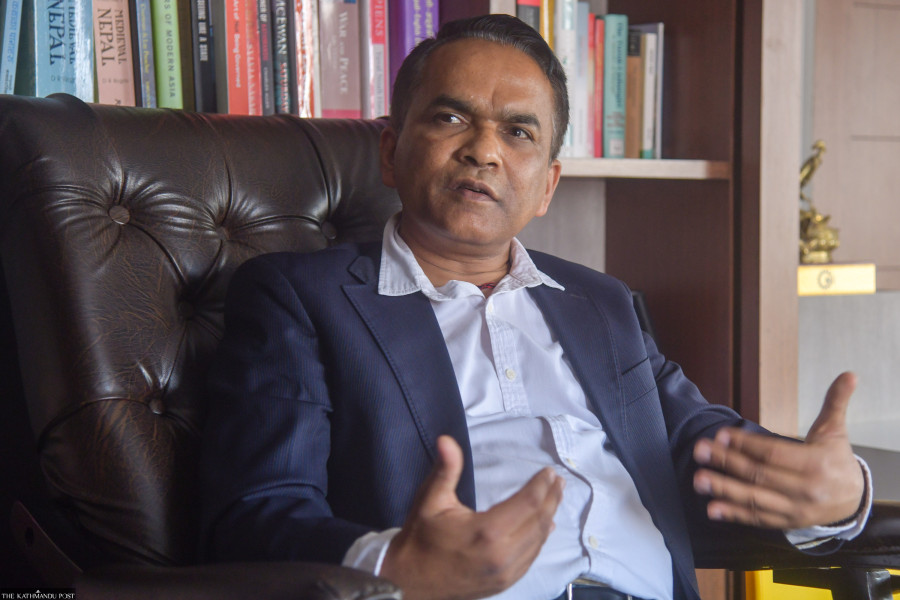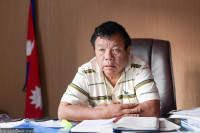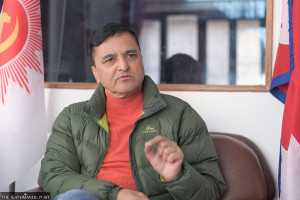Interviews
Remittance-fuelled economy has historically been detrimental to Nepal
We have to treat the issue of energy trade with India with the sensitivity it deserves. Energy supply is a sensitive issue for India.
Thira Lal Bhusal
The country’s economy that was badly hit by Covid pandemic has been unable to bounce back. The market is rather depressed and the government has failed to pep it up. Post’s Thira Lal Bhusal sat down with economist and former vice-chair of the National Planning Commission Biswo Poudel, who offers insights on Nepal’s historical as well as current economic policies and practices.
Let’s start with the current economic outlook, which is rather grim. While a huge amount of money is stacked in banks there is no economic activity in the market. How do you see this?
It’s true that the deposit is huge. According to Nepal Rastra Bank data, the deposit is over Rs6,100 billion while the lending is over Rs5,000 billion. It is for the first time that we have this amount of money deposited in banks. Also, we have significant foreign exchange reserves. But the problem is that there is no expenditure in the market. This indicates people don’t have confidence about the future of the market. People are neither spending nor borrowing. In this case, I think the Keynesian prescription should be followed. That suggests increasing government expenditure to encourage spending by the private sector, with the goal of rejuvenating overall market activities by creating demand.
If we see the trend since the start of the KP Oli government [formed in 2018], we find the government spent massively. It also started a borrowing spree—both domestic as well as external. Until 2000, the ratio of our borrowing portfolio used to be 80 percent external and 20 percent domestic. Now, it is almost 50-50. The interest rate of domestic borrowing is high. The average interest rate of our external borrowing is at around 0.8 percent while it is nearly 8 percent for domestic borrowing.
Also, the domestic borrowing is often for a short period. The total government loan which was around Rs600 billion in 2014-15 has now increased to about Rs2,400 billion. Moreover, the Oli government spent the money in unproductive sectors like building view towers. A total of 56 conference halls were built in the period. Airports were added. But none of them are now yielding revenue to pay back the original loan. Roads were built, but not in areas that would help with the economy. In many cases, contractors are reported to have received the signing money and went out of contact. To sum up, the government spent money, but is without any prospect of commensurate increase in revenue.
In fact, for the first time in two decades, our revenue last year saw a downfall compared to the previous year. Therefore, the government, which is the largest purchaser of the country, isn’t able to spend money as per the requirement. It remains under pressure to pay back loans and interests.
Many say the abrupt ban on import on a list of luxury items is one reason behind the plunge in revenue.
That’s not entirely true. At the time, the banned items were worth only around Rs60-70 billion. We took the decision as the foreign exchange was dwindling drastically. That was a temporary measure. Later, we relaxed it. We took such measures to stop the country from heading towards a crisis like the one Sri Lanka faced at the time. It was the problem of foreign exchange reserves. Of late, the government is under pressure to pay back its borrowing. It now badly needs more revenue, precisely at the time when its loans have increased and revenue has depleted.
We have long been an import-based economy and now our fiscal system is highly dependent on remittance. Isn’t this a dangerous state of affairs?
Dependence on remittance isn’t new for us. Our economy has been influenced by remittance at least since 1920. After the First World War, Nepalis brought Rs250 million, which at the time was equal to the country’s revenue of eight years. That suddenly increased our imports, mainly from the then emerging industrial nation of Japan, and destroyed our cottage industries. And, the 1923 treaty with British India removed the provision of having to pay tax in multiple points in India while importing goods from a third country via the southern neighbour. It was supposed to be good for us, but unfortunately it was not.
At the time Nepali business people started importing readymade goods instead of raw materials for manufacturing. These were the initial blows that hit our cottage and other domestic industries hard. Previously, the number of Nepalis going abroad was in the hundreds. But in the war time, hundreds of thousands of Nepalis went. And, they started receiving regular salaries, compensations for deaths and injuries and pension. Also, the rulers at the time were lured by that money as the entire revenue was directly controlled by the prime minister during the Rana regime. They found the money received through import licences, customs and remittance more attractive and didn’t bother to run industries. Thus remittance has historically weakened our domestic industries. We could have used the remittance wisely but we failed on that front as well. We will face consequences if we don’t think about changing the pattern of remittance-fuelled import-based economy.
What in your view is the right ratio of borrowing to the GDP?
There are some who argue that our current ratio of loan to GDP is 40-45 percent, which, according to them, is manageable. They cite examples of other countries that borrow in a ratio of 100 percent to the GDP. This argument holds only when the revenue is steadily increasing. Now we have to repay trillions of rupees while collecting just around Rs 11 trillion in revenue annually. Therefore, just considering the loan ratio to the GDP wouldn't be enough. If the revenue is in steady rise, you can borrow more. So, the government should explore ways to collect more revenue. The government took some measures but they didn’t work as expected. Last year, it lifted the import ban. Then, it lifted some restrictions on land plotting and also adopted flexibility on the stock market. None of these measures helped. Now, the government can’t spend much nor can our agencies spend money received from international donors such as the World Bank and the Asian Development Bank. Also, we have failed to expedite projects under the US-funded MCC and China’s BRI. The progress on road projects is also dismal.
Are we spending so little because we couldn’t increase our capacity in infrastructure development?
It has been a problem for the past seven decades. Development expenditure was at around 80 percent during the Panchayat era. In the past 20 years, we increased our budget size from Rs1 trillion to around Rs20 trillion. But the work capacity of our civil servants hasn’t increased. Even before Panchayat, around 1955, the Americans once expressed their willingness to provide $5 million to build roads in Nepal. But at the time we had no human resource to spend that money. Right from the Rana regime, there were schools to study languages but not for technical study. Even today, we lack technical expertise. We don’t have enough good engineers and competent project managers. On the other hand, the bureaucrats hesitate to head a project as they are harassed by various elements—such as those who aren’t awarded contracts. So, they don’t want to take a risk as the contractors have better access to power centres and can manipulate through mushrooming media. We started planned development activities around seven decades ago (2013 BS). The first fiscal budget was unveiled a few years before that (2008 BS). But targets specified in most periodic plans and fiscal budgets have been unmet.
How do you analyse the progress made in hydropower development in recent years?
Hydropower projects are built in Private-Public Partnership. Projects developed by the private sector are generating energy at a much cheaper price. They have succeeded in working as per their estimation. So, they have made decent profits. There is competition in the generation sector and it has helped hydropower producers grow their competence. But our government hasn’t allowed the private sector to build roads on their own. They work only as contractors. The state has entrusted them with the responsibility of building public infrastructure but it has not worked to enhance their capacity. If they don’t work properly, the quality of public infrastructure suffers. Political interference, frequent changes of project managers, problems in land acquisition, forest clearance, delay in removing existing structures such as utility poles and disputes on compensation issues and government’s failure to arrange matching funds in case of involvement of donor agencies are major barriers.
How do you assess the performance of multinational donors here?
Multinational agencies have also become too bureaucratic and their approval process is slow.
So what do you suggest the government do right now?
We are in a tricky situation. The government should work to increase its revenue. For that, it has to stimulate economic activities, which isn’t easy without first increasing revenue. In fact, failure to properly manage the border has caused huge loss in revenue. The government is losing around Rs100 billion due to lapses on the part of police and customs. A collaboration between home and finance ministries to regulate the border and help revenue collection has become crucial. Government should also promote the private sector like it did in the 1990s under almost similar circumstances.
There is some excitement in the energy sector after signing of the long-term power deal with India last year while some other issues such as transmission bottlenecks look quite challenging. What do you make of these dealings with India?
We have to handle the issue of energy trade with India very sensitively. They want a guarantee of certain things. They put conditions on import and export of energy. Energy supply is a sensitive issue for India. If we think they are our market, then we have to understand their sensitivity and deal with it deftly. India can give us access to a huge market while we can help them replace their coal-based energy. It can be win-win. For that, both sides should try to understand each other more.
How do you analyse disputes over international initiatives such as the American MCC compact project and Chinese BRI?
This isn’t the first time that an intense debate is taking place on foreign support in our development activities. The US was our largest donor from 1954 to early 1960s. Questions were raised even when China came forward to support us in building the Kodari Highway in the 1960s. It became a big issue. But we did it. In the 1950s, Indians helped us in communication, roads and airports. Some people at the time also protested against Indian involvement. But we did it too. Then, Russians came and helped us build roads and set up factories. In the meantime, the Americans and the British also helped us in various sectors. We managed all of them deftly. But now, building transmission lines with US support has been dragged into controversy and has been unnecessarily politicised. Also, the BRI needn’t be politicised. We have to seriously listen to the concerns of our neighbours and major development partner countries and manage the situation prudently.
While working at the National Planning Commission and other government bodies, how did you find the performance of provinces and local units in development activities?
It’s horrible. Both the provincial and local units are very poor on the development side. Their revenue and cost forecasts don't match. The provinces have to rely on the civil servants deployed by Singha Durbar. A particular chief minister, when he is well-connected here in Kathmandu, may perform better in certain aspects but the system of the provinces isn’t at all efficient. In fact, the centre hasn’t given them even basic things as promised in the constitution.
Some think provinces are unnecessary burdens to the state. Do you agree?
I don’t understand why people think that way. There were more structures and layers in the past. During the Panchayat, there were village units, districts, zones and development regions besides the central administration. There was conflict between chief district officers and zonal chiefs as the CDOs used to report to the home ministry while the zonal chiefs reported directly to the palace. There is a need for radical reform in the performance of provinces but it doesn’t mean they should be scrapped. They aren’t even allowed to exercise their constitutional rights.




 10.12°C Kathmandu
10.12°C Kathmandu












